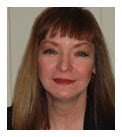
What You Should Know Before Walking Trade and Licensing Shows
by Suzanne Cruise
The number of trade shows that are put on each year is staggering. There is at least one trade show for virtually every product category you can imagine. The choices are unlimited. If you are just starting out in licensing, narrowing all of them down to the handful of the most worthwhile shows can be a daunting task. You first need to have some idea of what products your art would be suited for in order to cull out shows that would be a waste of time. For example, if your library of art consists primarily of beautiful florals, walking the Global Pet Expo is probably going to be a waste of time and money. Narrowing down the appropriate product applications is one great way to narrow down the shows that might be appropriate for you to walk. If you are a seasoned licensor, targeting the best trade shows to walk in order to find potential clients becomes much easier and often boils down to how much time and money you have to spend on attending shows, when these shows take place, and how many existing and potential clients are exhibiting at the shows. The number of licensing shows you can walk is quite small in comparison but the rules of the game are still the same.
As an artist, getting a badge to get into a trade show can be challenging, to say the least. Call the show management and ask the person who answers for information on badge registration. The phone numbers are always listed on the show web sites. Sometimes you are forwarded to another department but tell whoever you end up speaking with that you license your art to several of their exhibitors (if this is true) and that you are setting up appointments to meet with them. Ask them what credentials do you need to provide in order to obtain a badge. Since your occupation is one that falls through the cracks of the show's attendees, this approach works well in many cases. Another method is to pay your attorney to give you a document on their letterhead that states that you are the President and CEO of your company. The document lists your name, your company name and if you are a corporation (state that also), you are actively engaged in the sale and licensing of your artwork to companies that manufacture or distribute products utilizing such designs. Also your company is in good standing in the state of xx and has been doing business since xxxx date. That document and a business card will often suffice for the shows that ask for a business license. It is worth every penny that the lawyer charges.
Why walk a trade or licensing show?
Walking a trade show is the fastest and most efficient way of finding manufacturers who might be potential licensing partners. It is also a great way to see what trends, colors, and styles of art that are being offered in that particular industry.
For licensing shows, it is the most efficient way of finding a potential agent and a way to meet and establish talking relationships with fellow artists. It is also a very good way to find out if that show is worthwhile to exhibit your work.
How do you find trade and licensing shows?
Finding the various trade shows is relatively easy. Ask manufacturers which shows they (or their reps) exhibit in and if there are shows they (or their sales reps) walk. Another good resource are the local mom-and-pop gift stores that carry products your work can go on or that your work has been licensed to. These store owners have buying decisions to make and so they often will know the best shows to attend. I suspect many store owners would happily share this information and especially if you approach them on a day and time they are not swamped with customers. If they are busy, ask them if it would be more convenient to set-up an appointment to discuss trade shows. You can also try googling the type of shows you interested in finding by searching for licensing trade shows, gift trade shows, etc.
To find art licensing shows, read the article "
Art Licensing Trade Shows." Also ask fellow artists what shows they have exhibit in and/or have walked and what were their experiences. You can also ask agents. Some of them are going to be more helpful than others but they certainly should know what are the major shows to find potential clients. This is also an excellent question to ask an agent that you are considering hiring.
What should you wear?
I usually wear nice slacks and shirt or sweater. You might want to throw a thin cardigan sweater into your bag as some of these shows keep the AC so low I swear they must have meat hanging somewhere in the building. I also always wear a nice jacket or a jeans jacket. Over the years, show dress has become very casual. I have been known to wear jeans especially if the weather is bad, but I try to keep my jacket and shirt/sweater, a little more formal to offset the casualness of jeans. If you go the jeans route, be sure to wear ones that are clean and crisp, especially if you do not know the people you are seeing. But it is always good to fall back on the adage "dress in a way that shows you are a professional."
Can You take pictures of booths?
I don't know of any show that allows you to photograph anything without permission. If you see a booth you especially like, ask the exhibitor if they mind if you snapped a shot of it. But be prepared, for many people will say no. With the explosion of cameras in cell phones, some people think they can act like they are talking on the phone but they are really busy taking pictures. Don't be a total jerk and act like this.
What do you look for when walking a show?
So you have committed to walking a show. What do you do first? If you have never done the show before (and even if you have), get a copy of the show directory well in advance. It will list all of the exhibitors and where their booths/showrooms are located. Some shows also list all of their exhibitors online and most shows will list the products they manufacture. Make a list of potential clients (by product) whom you want to meet or just check out. If you are fairly new to shows, my suggestion is to take your list and just go aisle-by-aisle or floor-by-floor and spend more time in the booths you have marked ahead of time. Familiarize yourself with the product offerings. Keep a list of ALL the companies whose products look like a fit for your work and even make notes to remind yourself of the various things that stood out with a particular manufacturer. If you are more seasoned in walking shows, definitely start well ahead of the show to set-up appointments with the art directors of manufacturers and allow some time to just walk the show in order to find manufacturers that you may not know about.
In walking licensing shows (especially those you may want to exhibit in the future), take a notebook with you and write down all the details that strike you about the show. These can include the various types of booth layouts, where is the most traffic, where is the entrance and what direction do people seem to go when they walk into the show, how the exhibitors interact with customers, what methods do the exhibitors use to draw customers into the booth, what are the exhibitors wearing, how did they display their work, how much (or little) did they display on their booth walls, how much lighting is overhead and in the booths, how are the tables and chairs positioned, etc.
Use proper trade show etiquette.
When I walk into a booth or showroom and have no appointment and if anyone asks if they can help me, I ALWAYS say no thank you. I then ask, "Do you mind if I look through your showroom (booth)?" Rarely will they say no. The exception to this are showrooms that have a desk/receptionist at the front door. You probably will not get by them without an appointment or without a contact name. And do not eat any of the food and/or drinks in the booths/showrooms because they are for the buyers.
If you are in a showroom and think your work might be suitable for the manufacturer, tell one of the reps that you would like to show your art to the person who handles art reviews AFTER (emphasize the "AFTER") the show. State clearly that you do not want to bother anyone during the show. Ask the rep for the contact information of the art or licensing person. Nine times out of ten you will score with this approach.
Use proper licensing show etiquette.
When walking shows, NEVER EVER EVER go up to agents and ask if they will look at your work when they are speaking to other people or even if their booth is loaded with people. NEVER EVER approach agents even if it looks like they are in a conversation among friends. Do not approach them UNTIL they are alone. ONLY WHEN THEY ARE ALONE or not working with a client should you approach them and ask if they have any time to look at new art. Some agents will take the time to look at your work if they are not busy or expecting an appointment. Some agents will never take the time to look at work during a show. You simply have to ask for their submission policy and abide by it. Some shows will not let you bring portfolios into the show at all. Ask about that policy before you attend the show. If you cannot bring a portfolio, have a tear sheet or small handout (preferably with your web site listed) that you can discreetly show and/or leave with the agent.
As far as talking to other artists who are exhibiting, I would suggest that you apply the same rules. They have paid money to exhibit in order to find new clients and schmooze with existing accounts. It is a show of courtesy and respect to let them do their work and only approach them when it appears they are not knee-deep in discussing their art with clients. I suspect the artists are just like the agents. Some are very forthright and helpful and some are very closed mouth and guarded.















 J'net Smith
J'net Smith

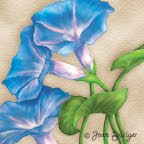
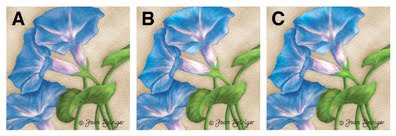

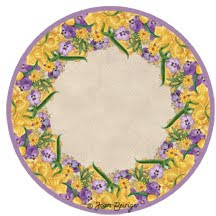 Unfortunately, in Photoshop you cannot automatically place a border of art around the outer edge of a circle. This tutorial demonstrates a method that takes a little work but is still fairly simple to do once you know how.
Unfortunately, in Photoshop you cannot automatically place a border of art around the outer edge of a circle. This tutorial demonstrates a method that takes a little work but is still fairly simple to do once you know how.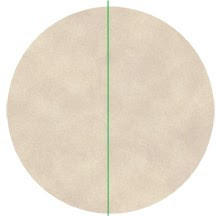
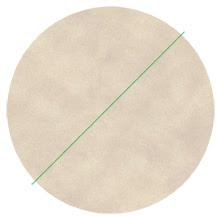
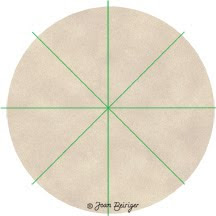
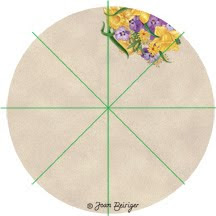
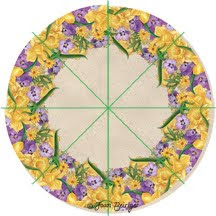














.jpg)
.jpg)



